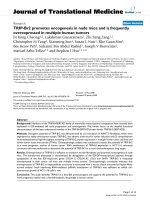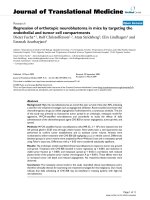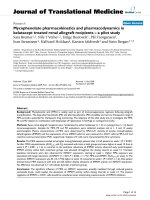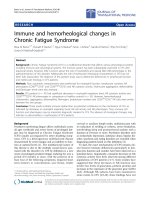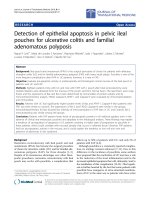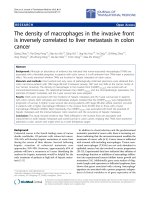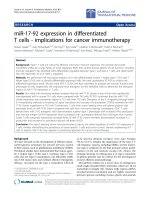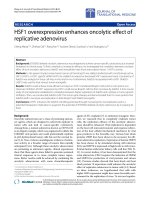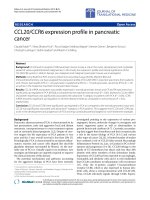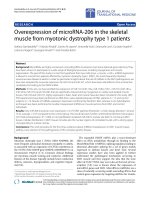Báo cáo hóa học: " Accidental organophosphate insecticide intoxication in children: a reminder" potx
Bạn đang xem bản rút gọn của tài liệu. Xem và tải ngay bản đầy đủ của tài liệu tại đây (194.06 KB, 4 trang )
CAS E REP O R T Open Access
Accidental organophosphate insecticide
intoxication in children: a reminder
Willemijn van Heel and Said Hachimi-Idrissi
*
Abstract
Misuse of organophosphate insecticides, even in case of domestic application, can be life threatening. We report
the case of siblings admitted with respiratory distress, pinpoint pupils and slurred speech. The symptoms appear
after spraying the skin by insecticides. Plasma pseudocholinester ase level appeared to be very low, consistent with
acute intoxication with organophosphate insecticide.
Management of organophosphate poisoning consists of airway management, administration of oxygen and fluid,
as well as atropine in increasing doses and pralidoxime. Decontamination of the patient’s skin and the removal of
the patient’s clothes are mandatory in order to avoid recontamination of the patient as well as the surrou nding
healthcare personnel.
Plasma pseudocholinesterase analysis is a cheap and an easy indicator for organophosphate insecticides
intoxications and could be used for diagnosis and treatment monitoring.
Keywords: Plasma pseudocolinesterase, insecticides, intoxication, organophosphorus compound, antidote, children
Introduction
Organophosphate insecticides are widely used in rural
areas. Intentional ingestion of organophospha tes is asso-
ciated with a high mortality rate [ 1]. Organophosphate
intoxication (OI) induces irreversible inhibition of acet-
ylcholinesterase. Organophosphates phosphorylate the
serine hydroxyl group o f acetylcholine, leading to accu-
mulation of acetylcholine at the cholinergic synapses [2].
This accumulation leads to weakness and fasciculation
of the muscle. In the central nervous system, neural
transmission is disrupted. If this blockade is not
reversed within 24 h, large amounts of acetylcholinester-
ase are permanently destroyed [3].
Acetylcholinesterase is found in red blood cells as well
as in nicotinic and muscarinic receptors. To determine
the severity and/or the elimination time of OI, one
should measure cholinesterase in blood, either by mea-
suring plasma pseudocholinesterase (PCE) or by measur-
ing the cholinesterase in erythrocytes (which is thought
to reflect the cholinesterase in neurons and neuromus-
cular junctions). The first method is widely available
and therefore commonly used [3,4].
Herein, we report a case of siblings who, upon being
sprayed with an organophosphate solution, developed
severe OI associated with central nervous system (CNS)
depression.
Case report
A 7-year-old previously healthy boy was brought into
the emergency department with vomiting and reduced
consciousness by his mother. He had been in good
health until he was found, 30 min prior to admission,
unresponsive in the bathroom. The mother was not able
to provide more information.
At admission, the health care personnel had smelled an
unspecified and unpleasant odour. The physical examina-
tion of the boy showed pinpoint pupils (2 mm dia meter),
hypersalivation and lacrimation. He was responsive to
pain, but had slurred speech. His Glasgow Coma Scale
(GCS) score was 9. Upo n presentation, his vital signs
included a rectal temperature of 36.8°C; heart rate, 117
beats/min; respiratory rate, 38 breaths/min; blood pres-
sure, 112/58 mmHg; and haemoglobin saturation, 96%.
Lung auscultation revealed bilateral wheezing. He had no
abdominal tenderness, distension or hepatomegaly. The
skin was warm a nd clammy with capillary refill (CR) of
less than 2 s. Eight minutes after admission, his heart
* Correspondence:
Universitair Ziekenhuis Brussel (UZ Brussel), Paediatric Intensive Care Unit,
Laarbeeklaan 101, 1090 Brussels, Belgium
van Heel and Hachimi-Idrissi International Journal of Emergency Medicine 2011, 4:32
/>© 2011 van Heel and Hachimi-Idrissi; licensee Springer. This is an Open Access article distributed under the terms of the Creative
Commons Attribution License ( which permits unrestricted use, di stribution, and
reproduction in any medium, provided the original work is properly cited.
rate suddenly dropped down to 50 beats/min, followed by
respiratory arrest. After orotracheal intubation, mechani-
cal ventilation and atropine administration (0.02 mg/kg
every 5 min), the patient’s condition stabilized.
The cause of the symptoms was unclear, but intoxica-
tion with opiates or an organophosphorus compound
(OC) was considered [5]. Th e patient’ssymptoms,the
recovery after atropine administration and the occur-
rence of headache in the involved health care personnel
indicated probable OI.
Shortly thereafter, the boy’s 10-year-old sister, with the
exact same un pleasant odour, altered sensorium, vomit-
ing and respiratory distress, was brought to the emer-
gency department by the father. She was afebrile and had
a heart rate of 133 beats/min; the respiration was shallow
at a rate of 31 breaths/min with bilateral wheezing and
bronchial secretions. Her blood pressure was 131/76
mmHg, and the GCS was 15. Her pupils were 1 mm in
diameter, and the CR was prolonged up to 4 s. She was
stabilized with oxygen administration through a non-
rebreathing mask and a 20 ml/kg bolus of saline fluid
through a secure d intravenous vascular catheter. Because
OI had been suspected earlier for her brother, atropine
(0.05 mg/kg) was given to prevent further decline.
Both children wer e transferred to the paediatric inten-
sive care unit (PICU).
All laboratory values were normal, except for a
decreased PCE. The boy’sPCEwas0.3kU/landthe
girl’s 0.2 kU/l (laboratory reference range: 4.6-10.4 kU/l).
These clinical and biological findings confirmed our
diagnosis of OI.
Subsequently, the girl told us that they had been
spraying fluid from a bottle while playing in the bath-
room. Later on, the mother admitted that she had filled
the bottle with pesticid e to eradicate insects in the
house, and subsequently analysis of the bottle’ s solution
showed a high concentration of OC.
The boy was kept on mechanical ventilation for the
next 24 h. He was treated with large fluid infusions,
atropine (0.05 mg/kg every 15 min) and pralidoxime (25
mg/kg every 6 h).
The frequency of atropine administration was reduced
and finally stopped when symptoms such as bradycardia,
hypersecretion and bronchospams disappeared. Both
patients improved considerably, although the boy
showed fasciculations for an additional day. After t he
atropine treatment had been stopped, pralidoxime was
slowly decreased and stopped after 6 days. His PCE level
was 4.3 kU/l on day 10 (Figure 1).
The sister was treated with two doses of atropine (0.05
mg/kg) and pralidoxime (25 mg/kg every 6 h). The pra-
lidoxime dosage was rapidly reduced and finally stopped
after 4 days. Her PCE level was 4.6 kU/l on day 10 as
well (Figure 1).
The children were discharged from the PICU on day 6
and from the hospital on day 10 without any sequelae.
Further evaluation o f the siblings 2 weeks later showed
normal clinical findings, and the PCE values were within
the normal range.
Discussion
The striking similarity and timely fashion of the clinical
presentation of these sib lings suggested either a toxic
environmental exposure or ingestio n. Both children had
some elements of CNS depression, respira tory difficulty,
hypersecretion and miotic p upils. This constellation of
findings is highly suggestive of a cholinergic toxidrome,
and additional inquiry revealed exposure to OC.
OCs are commonly used in a gricultural products,
including insecticides and defoliants. They are rapidly
absorbed by all routes of exposure, including dermal,
respiratory and gastrointestinal, and irreversibly inhibit
the enzyme acetylcholinesterase at cholinergic synapses,
resulting in excess cholinergic stimulation at the neuro-
muscular junction, the sympathetic and parasympathetic
nervous systems, and the CNS [3].
In our patient s the absorption was probably via differ-
ent routes, the s kin, and the mouth, and/or via the
respiratory tract while they were spraying the solution at
each other in the bathroom.
The initial management should be directed toward
securing and maintaining a stable patent airway and
assuring adequate gas exchange and end-organ perfu-
sion. Once these elements are stable and secure, efforts
can be directed toward establishing a definitive diagnosis
and treatment.
Unlike adults, infants mainly present with a cute CNS
depression [6] and do not demonstrate the typical mus-
carinic effects. Symptoms such as fasciculation, brady-
cardia and acut e respiratory failure are more common
in children [7].
Tachycardia, rather than bradycardia, has bee n noted
upon presentation in 49% of children presenting with
OI [6].
The acute respiratory failure in our cases was likely
multifactorial in origin, resulting from secretions and
bronchospasm from muscarinic stimulation. In addition,
stimulation of nicotinic receptors causes weakness and
paresis of the respiratory muscles [8].
The bradycardia event i n our first case was most
probably secondary to an apneic episode.
Acute OI is a clinical diagnosis. Red blood cell choli-
nesteraselevelsareusuallymarkedlydiminished,but
this laboratory test is seldom readily available. Although
plas ma PCE levels may be diminished as well, still there
is little correlation with acetylcholinesterase activity in
either the brain or at the neuromuscular junction [4,9].
However, the decrease in PCE levels may serve as a
van Heel and Hachimi-Idrissi International Journal of Emergency Medicine 2011, 4:32
/>Page 2 of 4
marker of exposure to OC and supports the diagnosis.
The diagnosis is therefore based on a history of expo-
sure, recognition of the cholinergic toxidrome, and
improvement or resolution of s ymptoms after appropri-
ate treatment [4,9,10].
Treatment is aimed at reversal of muscarinic signs
with atropine and enzyme reactivation b y pralidoximes.
Frequent atropine doses or continuo us titrated infusions
are used to achieve drying of secretions and the resolu-
tion of bradycardia [11,12]. Tachycardia, however, is not
a contraindication to atropine administration [12]. The
pupillary response (r esolution of miosis) is not consid-
ered an end point of atropine therapy, as miosis may
persist for weeks after significant exposure [11]. In our
cases, the miosis was resolved within 12 and 24 h in the
girl and boy, respectively.
Unfortunately, atropinization does not reverse either the
central or nicotinic cholinergic signs or symptoms, parti-
cular ly the muscle weakness and/or paralysis. A different
dose of pralidoxime or a continuous infusion is used in
severe poisoning up to the resolution of the symptoms or
restoration of normal plasma PCE levels [13].
This antidote is best used as early as is reasonable
before irreversible inhibition of acetylcholinesterase
occurs. A loading dose of 25 to 50 mg/kg followed by a
repetitive administration or a continuous infusion of 10
to 20 mg/kg per hour is administered until muscle
weakness and fasciculation resolve [14].
Note that health care personnel can develop OI
through either dermal or respiratory exposure, and mea-
sures should be taken in order to avoid this. In our
cases the health care personnel involved developed
headaches, but this situation was quite easily resolved by
aeration of the room where the patients were treated.
Moreover, we should advise the personnel to wear
gloves, masks and glasses when decontaminating the
patient’ s skin and to hermitically seal the patients’
clothes in a closed bag [1].
Conclusion
This report emphasizes that misuse of OC, even in cases
of domestic application, may be life threatening. This
can cause acute OI even through the skin.
Management of OI consists of airway management;
administration of oxygen and fluid, atropine in increas-
ing doses and pralidoxime; as well as decontamination
of the patient’s skin.
The involved health care personnel should be aware of
the potential risk of becoming intoxicated themselves
when taking care of contaminated patients.
PCE analysis is an easy indicator of OI and can be
used for treatment monitoring.
Authors’ contributions
WH intervened the patient in the emergency department and drafted the
manuscript. SHI was the supervising physician who diagnosed OI and
Pseudocholinesterase level during hospitalisation
0,20,2
0,4
1,1
1,3
2
2,7
3,5
4,6
0,2
0,3
1,1
1,1
1,3
2,1
3,1
4,1
4,3
0
0,5
1
1,5
2
2,5
3
3,5
4
4,5
5
01234 5678910
Days of hospitalisation
Serum Pseudocholinesterase (kU/L)
Boy
Girl
Figure 1 Pseudocholinesterase levels of our patients during hospitalisation.
van Heel and Hachimi-Idrissi International Journal of Emergency Medicine 2011, 4:32
/>Page 3 of 4
treated the patients and corrected the manuscript. All authors read and
approved the final manuscript.
Competing interests
The authors declare that they have no competing interests.
Received: 7 September 2010 Accepted: 15 June 2011
Published: 15 June 2011
References
1. Eddleston M, Buckley NA, Eyer P, Dawson AH: Management of acute
organophosphorus pesticide poisoning. Lancet 2008, 371:597-607.
2. Aygun D: Serum acetylcholinesterase and prognosis of acute
organophosphate poisoning. J Toxicol Clin Toxicol 2002, 40:903-910.
3. Leibson T, Lifshitz M: Organophosphate and carbamate poisoning:
Review of the current literature and summary of clinical and laboratory
experience in southern Israel. IMAJ Nov 2008, 10.
4. Aygun D: Diagnosis in acute organophosphate poisoning: report of
three interesting cases and review of literature. Eur J Emerg Med 2004,
11:55-58.
5. Lee P, Tai DY: Clinical features of patients with acute organophosphate
poisoning requiring intensive care. Intensive Care Med 2001, 27:694-699.
6. Zwiener RJ, Ginsburg CM: Organophosphate and carbamate poisoning in
infants and children. Pediatrics 1988, 81:121-126.
7. El-Naggar AE, Abdalla MS, El-Sebaey AS, Badawy SM: Clinical findings and
cholinesterase levels in children of organophosphates and carbamate
poisoning. Eur J Pediatr 2009, 168:951-956.
8. Nel L, Hatherill M, Davies J, Andronikou S, Stirling J, Reynolds L, Argent A:
Organophosphate poisoning complicated by a tachyarrhythmia and
acute respiratory distress syndrome. J Paediatr Child Health 2002,
38:530-532.
9. Bardin PG, van Eeden SF, Moolman JA, Foden AP, Joubert JR:
Organophosphate and carbamate poisoning. Arch Intern Med 1994,
154:1433-1441.
10. O’Malley M: Clinical evaluation of pesticide exposure and poisonings.
Lancet 1997, 349:1161-1166.
11. Clark RF: Insecticides: organic phosphorus compounds and carbamates.
In Goldfrank’s Toxicologic Emergencies 7 edition. Edited by: Goldfrank LR,
Flomenbaum NE, Lewin NA, Howland MA, Hoffman RS, Nelson LS. New
York: McGraw-Hill; 2002:1346-1365.
12. Johnson MK, Jacobsen D, Meredith TJ, Eyer P, Heath AJ, Ligtenstein DA,
Marrs TC, Szinicz L, Vale JA, Haines JA: Evaluation of antidotes for
poisoning by organophosphate pesticides. Emerg Med 2000, 12:22-37.
13. Hoffman RS, Nelson LS: Insecticides: organophosphorus compounds and
carbamates. Goldfrank’s manual of toxicologic emergencies New York:
McGraw Hill; 2007, 841-847.
14. Schexnayder S, James LP, Kearns GL, Farra HC: The pharmacokinetics of
continuous infusion pralidoxime in children with organophosphate
poisoning. J Toxicol Clin Toxicol 1998, 36
:549-555.
doi:10.1186/1865-1380-4-32
Cite this article as: van Heel and Hachimi-Idrissi: Accidental
organophosphate insecticide intoxication in children: a reminder.
International Journal of Emergency Medicine 2011 4:32.
Submit your manuscript to a
journal and benefi t from:
7 Convenient online submission
7 Rigorous peer review
7 Immediate publication on acceptance
7 Open access: articles freely available online
7 High visibility within the fi eld
7 Retaining the copyright to your article
Submit your next manuscript at 7 springeropen.com
van Heel and Hachimi-Idrissi International Journal of Emergency Medicine 2011, 4:32
/>Page 4 of 4
